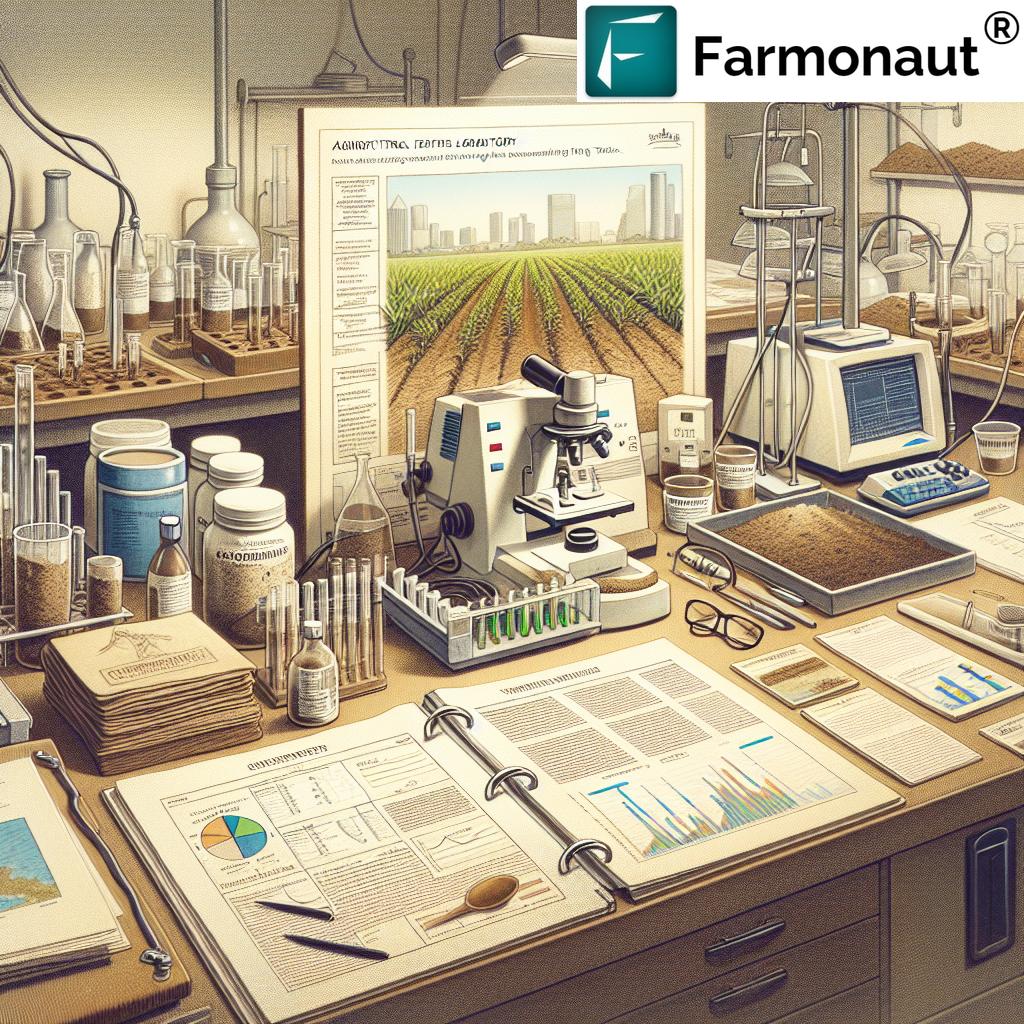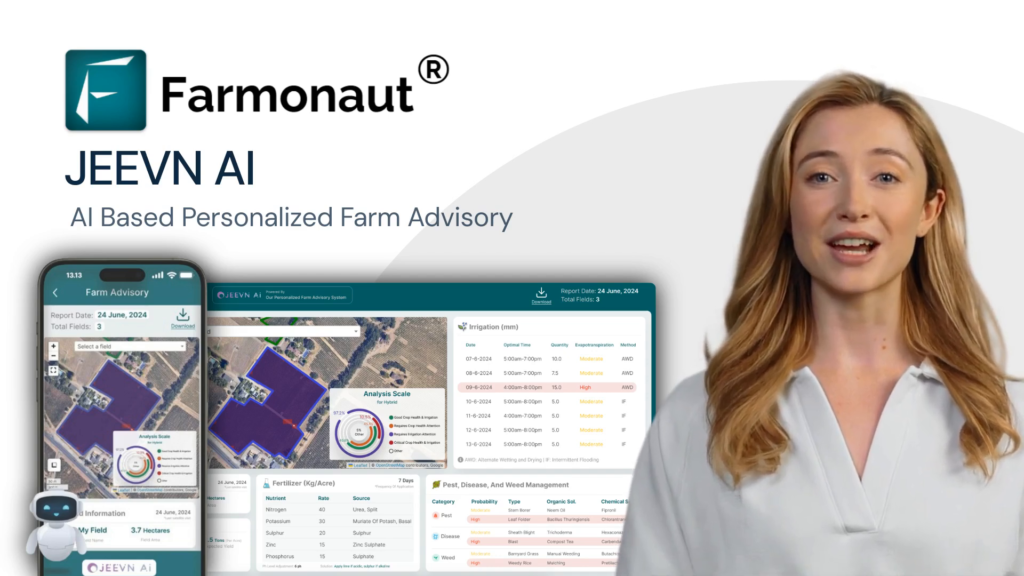Table of Contents
- Introduction
- Trivia: How Soil Testing is Transforming Houston Agriculture
- Understanding Soil Testing: Fundamentals for Houston and Texas
- Soil Testing Houston: 7 Powerful Benefits for Crop Health
- Comparative Benefits Table: Houston Soil Analysis
- Unique Soil Types and Challenges in Houston Region
- Soil Sampling Procedures: Getting Accurate Results
- Soil Analysis Texas: Testing Services and Labs in Houston
- Best Time for Soil Testing and Seasonal Considerations
- Advancements in Soil Testing Technologies for Sustainable Agriculture
- Integrating Satellite & AI: Farmonaut’s Role in Crop & Soil Health Monitoring
- How to Access Advanced Farm Soil Monitoring Tools
- FAQ: Soil Testing Houston and Crop Health
- Conclusion
“Soil testing in Houston can increase crop yields by up to 30% through precise nutrient management.”
Soil Testing Houston: 7 Powerful Ways to Boost Crop Health
Welcome to our comprehensive guide on Soil Testing Houston and the science of soil analysis Texas. As agricultural professionals, we know that understanding the composition and fertility of our fields is the foundation of crop productivity, sustainability, and environmental stewardship. In Houston, where agriculture must balance rapid urbanization, diverse crops, and unique soils, soil testing is more than a recommendation—it’s a vital practice for sustainable land management and yield optimization.
Let’s explore how soil testing Houston—when performed correctly and interpreted with expert tools—elevates nutrient management, reduces costs, prevents environmental harm, and positions our farms for success year after year.
Understanding Soil Testing: Fundamentals for Houston and Texas
Soil testing forms the backbone of sustainable agriculture practices. This fundamental practice involves analyzing soil samples to determine nutrient levels, pH, organic matter, and the presence of contaminants. Whether we’re cultivating grain sorghum in the iconic Houston black soils or managing forests on Texas prairies, regular testing and proper sampling provide us with the data needed for informed decisions on fertilization, amendments, and crop selection.
The key parameters examined during soil analysis Texas include:
- Macronutrients: Nitrogen (N), Phosphorus (P), Potassium (K)
- pH: The measure of acidity or alkalinity, critical for nutrient uptake
- Organic matter: Influences soil structure and fertility
- Micronutrients: Iron, Zinc, Copper, Manganese, Boron, etc.
- Contaminants: Such as heavy metals or residual chemicals
This analytical approach supports soil health monitoring, environmental sustainability in agriculture, and aligns with the principles of nutrient management for crops.
Soil Testing Houston: 7 Powerful Benefits for Crop Health
In the context of Houston’s unique soil types and climate, regular soil testing unlocks numerous advantages. Here, we detail the seven most powerful benefits for crop health and sustainability:
-
Precise Fertilizer Use:
Comprehensive soil analysis identifies the exact nutrient deficiencies or surpluses in our fields. Knowing soil nutrient levels empowers us to apply fertilizers efficiently—whether we’re growing corn, cotton, or forage—maximizing growth, minimizing runoff, and reducing waste. This targeted approach prevents over-fertilization and supports crop yield optimization Texas.
-
Cost Savings:
By uncovering existing reserves of nitrogen and other key nutrients, we avoid unnecessary fertilizer applications. According to studies in Texas, deep soil testing can deliver cost savings ranging from $13 to $189 per acre, especially on Houston Black soils famed for their nutrient-holding capacity. This results in more sustainable bottom lines for farmers.
-
Environmental Sustainability in Agriculture:
Guided fertilization minimizes nutrient runoff, protecting surface water and groundwater from pollution. Precise soil health monitoring safeguards the region’s natural resources, ensuring sustainable practices for generations to come.
-
Soil Health Monitoring and Early Interventions:
Tracking soil composition and organic matter over time makes it possible to spot emerging nutrient imbalances or contaminant build-ups early. Timely responses—like amending the soil with lime or compost—help us maintain soil vitality, structure, and productive capacity.
-
Promoting Sustainable Crop Management:
Informed decisions about crop selection, crop rotation, and fertilization rest on understanding the health and profile of our soils. Soil testing Houston enables us to adapt quickly to changing field conditions, and to design interventions based on real data rather than guesswork.
-
Boosting Crop Yields:
By delivering essential nutrients in the correct amounts, and maintaining optimal soil pH, we create the perfect environment for strong, resilient crops. Our practice of regular testing has been shown to produce yield increases of up to 30% for Houston region growers.
-
Documentation and Compliance:
Soil test results help in meeting the evolving environmental and regulatory standards in Texas, documenting responsible management that benefits our farmland, communities, and future market access.
Comparative Benefits Table: Houston Soil Analysis
To understand soil testing Houston benefits at a glance, review our comparative table below. It summarizes key soil parameters, their optimal ranges for Houston and Texas, common issues, and the direct crop benefits of correction. This information supports fertility optimization, sustainable agriculture, and maximum crop yield.
| Soil Parameter | Estimated Optimal Range (Houston/Texas) | Common Deficiency Issue | Benefit of Correction |
|---|---|---|---|
| Nitrogen (N) | 20-40 mg/kg (ppm) | Low protein & stunted plant growth | Promotes leafy growth, higher yields, enhanced vigor |
| Phosphorus (P) | 15-25 mg/kg (ppm) | Poor root/seed development | Improved root growth, earlier maturity, more productive crops |
| Potassium (K) | 100-150 mg/kg (ppm) | Frailty, lodging, drought stress | Stronger stems, increased drought resistance, better quality grains |
| pH | 6.0 – 7.0 | Nutrient lock-out, acid toxicity | Optimal nutrient uptake, healthy microbe activity |
| Organic Matter | 2-4 % | Poor soil structure, low nutrient retention | Better moisture retention, improved structure & fertility |
| Micronutrients (Zn, Fe, B, Mn, Cu) | Varies, Zn 1-3 mg/kg; Fe 11-17 mg/kg | Chlorosis, leaf deformities, low yields | Disease resistance, strong growth, improved quality |
“Over 60% of Texas farmers use soil analysis to reduce fertilizer waste and support sustainable agriculture.”
Unique Soil Types and Challenges in Houston Region
The Houston region presents distinctive soil types and agricultural challenges. The iconic Houston black soil—a vertisol recognized as the state soil of Texas—spans well over 1.5 million acres in the Texas blackland prairies. Rich in clay content, these soils are:
- Widely used for grain sorghum, cotton, corn, small grains, and forage grasses
- Subject to cracking, swelling, and shrinking due to clay minerals
- Prone to water retention issues and periodic drainage challenges
Understanding the nutrient profile and pH of Houston black soils is essential for optimizing crop health and tapping into their natural fertility.
Other Houston area soils include alluvial soils along rivers and loamy/sandy types, each with distinct management needs. That’s why soil testing Houston and periodic sampling are especially critical for crop yield optimization Texas.
Soil Sampling Procedures: Getting Accurate Results
Accurate soil testing always starts with proper sampling techniques. We cannot achieve reliable data or actionable recommendations without careful sample collection. Here’s how to collect and prepare samples for submission to an agricultural soil testing laboratory serving Houston:
- Sampling Depth: For most annual crops and pastures, collect soil from the top 6–8 inches. For perennials or deep-rooted plants, go deeper according to the crop’s root profile.
- Sampling Method: Use a soil probe, auger, or spade to take samples at 10–20 spots across each uniform management zone of the field. Avoid edges, old compost piles, or obviously disturbed ground, which can skew the results.
- Composite Sample: Thoroughly mix all cores from a single field in a clean container, remove debris, and air-dry at room temperature.
- Sample Quantity: Place about one pint (or lab-required amount) of thoroughly mixed, dried soil in a clean, labeled plastic bag or container.
- Submission: Follow the laboratory’s instructions for packaging and mailing. Correct, timely submission ensures you’ll receive accurate test results for effective crop planning and fertilization.
Our thorough soil sampling procedures form the basis for actionable soil analysis Texas insights, better nutrient management for crops, and environmental protection.
Soil Analysis Texas: Testing Services and Labs in Houston
Farmers and land managers throughout the Houston area can access agricultural soil testing services from a variety of trusted sources, including:
- Texas A&M AgriLife Extension Service: This state leader offers research-based soil analysis, measuring nutrient levels, pH, and organic matter. Their results are trusted for making actionable fertilization and amendment decisions.
- Local County Extension Offices: For Houston and surrounding communities, county agents offer field sample assistance, lab service guidance, or even sample collection support to make the process easy and accurate.
- Private Labs and University Cooperation: Many commercial and academic labs in Texas offer soil, water, and plant analysis with quick turnaround, ensuring that you gain timely, reliable results.
Periodic submission of samples to one or more of these entities—especially ahead of planting and post-harvest—guarantees that management decisions align with real-time conditions in your soil profile.
Best Time for Soil Testing and Seasonal Considerations
The timing of soil testing dramatically impacts the relevance and accuracy of your results. In Houston and Texas, expert guidance recommends:
- Pre-Planting: Sample in winter (January–March) before soil amendments or fertilizer application. This allows time for interpreting test data and making necessary practices adjustments before new crop cultivation.
- Post-Harvest: End-of-season tests reveal nutrient depletion and field condition changes, but may require confirmation closer to the next planting cycle due to natural biological changes.
- Frequency: For stable fields, test every 2–3 years; for high-production or intensively managed fields, annual testing is recommended.
By aligning the best time for soil testing with your farm’s operational cycle, you maximize the impact of soil health monitoring and ensure timely interventions that promote yield, sustainability, and stewardship.
Advancements in Soil Testing Technologies for Sustainable Agriculture
The science of soil testing and soil analysis has dramatically advanced in recent years—especially in Texas—thanks to digital transformation. Here are the key innovations influencing environmental sustainability in agriculture:
- On-Site Testing Devices: Simple, portable kits allow farmers to measure pH and nutrient status in the field using color sensors or test strips, speeding up decision-making (see study).
- Mobile Apps & Digital Analysis: Modern mobile platforms allow us to order tests, track results, and access management recommendations directly from any device.
- AI and Satellite Integration: Technologies like Farmonaut’s platform now overlay real-time crop images, soil moisture maps, and weather forecasts with laboratory test results to provide instant, data-driven field advice.
Such advancements in soil testing are crucial for both sustainability and productivity. They help us avoid waste, respond to early warnings, and continuously improve our agricultural outcomes.
For advanced farm monitoring and real-time field data via satellite, visit Farmonaut’s Large-Scale Farm Management App—ideal for agribusinesses, government projects, and NGOs needing robust oversight.
To understand your operation’s carbon footprint and take steps towards improved sustainability and compliance, explore Farmonaut’s Carbon Footprinting Tool. This feature leverages satellite data for accurate, actionable environmental reporting.
And for agricultural supply chains that value sustainability and provenance, Farmonaut offers a blockchain-based Product Traceability platform that assures transparency and fosters consumer trust.
Farmonaut Subscription Plans
Ready to transform your soil and farm monitoring experience? Review our affordable precision agriculture plans below:
Integrating Satellite & AI: Farmonaut’s Role in Crop & Soil Health Monitoring
Farmonaut is at the forefront of making precision agriculture affordable, accessible, and actionable for all farmers in Houston, Texas, and beyond. By harnessing multispectral satellite imagery, AI-based advisory, and advanced data analytics, Farmonaut provides:
- Real-time crop health monitoring: Monitor crops for stress, disease, or nutrient deficiency using NDVI and vegetation indices.
- Soil moisture mapping: Track field moisture and irrigation effectiveness to avoid under- or over-watering.
- Personalized farm advice: Farmonaut’s Jeevn AI delivers crop management guidance tailored to your soil analysis results, local weather, and historical performance.
- Resource and fleet optimization: Optimize equipment use and logistics—see Fleet Management Tools—reducing both costs and environmental impact.
- Blockchain-based traceability: Secure supply chain and product provenance from field to vendor (Product Traceability feature).
With Farmonaut, Texas growers get the power to overlay laboratory soil test results with dynamic crop data—enabling prompt, data-driven interventions that sustain yields and build resilience against climate and market pressures.
Available on web, Android, and iOS, Farmonaut delivers ready access to all your land, soil, and crop data, wherever you farm.
API integrations empower researchers, seed producers, and fintech companies to automate on-farm validation; visit the Farmonaut API portal or review Developer Documentation.
How to Access Advanced Farm Soil Monitoring Tools
Experience the benefits of cutting-edge agricultural soil testing services, AI-driven recommendations, and comprehensive field analysis by using one of the following Farmonaut access points:
- Web App for desktop and browser users—manage multiple fields, review data overlays, and download test reports.
- Android & iOS Apps for in-field monitoring, image capture, and real-time alerts during sampling or cultivation.
- API Access—Ideal for agritech developers, co-ops, and research groups integrating farm monitoring directly into their platforms.
All tools ensure mobile responsiveness, user-friendly dashboards, and secure, up-to-date data whether you manage 1 or 10,000+ acres in Houston or anywhere in Texas.
Visit Farmonaut’s Crop Loan and Insurance service to see how satellite-powered farm verification accelerates access to finance and reduces insurance fraud.
FAQ: Soil Testing Houston and Crop Health
Why is soil testing essential for Houston farmers?
Houston soils are diverse and include Houston black soils famous for their clay and nutrient-holding potential. Without regular soil testing, farmers risk both under- and over-fertilization, wasted costs, and unnecessary environmental impacts.
How often should we conduct soil analysis in Texas?
For intensively managed or high-value crops, annual soil testing before planting is ideal. Otherwise, a 2–3 year cycle is acceptable for most stable fields, but always test before making major crop or amendment changes.
What is the best time for soil testing Houston fields?
Conduct soil sampling procedures in late winter or early spring before fertilization. Post-harvest testing also provides useful data for field restoration.
Are digital and satellite tools effective for soil analysis?
Yes—while laboratory tests remain the gold standard for nutrient levels and pH, digital platforms like Farmonaut provide valuable, field-wide context, trend analysis, and decision support using satellite imagery, weather data, and AI-powered analytics.
Can soil testing help lower input costs?
Absolutely. By precisely tailoring fertilizer and amendment rates to real measured needs, soil testing delivers major cost savings while avoiding overuse and waste.
How does soil pH influence crop health in Houston?
Soil pH determines the availability of important macro- and micronutrients. Houston black soils often run slightly alkaline; monitoring and adjusting pH as needed (6.0–7.0 is optimal) improves crop growth and nutrient uptake.
Is organic matter particularly important for Texas fields?
Yes—for both structure and nutrition. Soil organic matter boosts nutrient availability, retains moisture in drought-prone profiles, and fosters beneficial microbes, all essential for healthy, sustainable crops.
Which crops benefit the most from soil testing Houston?
All regional crops—including cotton, corn, sorghum, small grains, and forage grasses—show better yields, quality, and resilience when their fertilities are monitored with regular soil analysis.
Conclusion
In the Houston region—and all of Texas—soil testing is more than a routine: it’s a pathway to sustainable agriculture, profitable crop production, and long-term stewardship of our lands. By analyzing samples for nutrient levels, pH, organic matter, and more, we unlock actionable information that drives smarter, more sustainable decisions on every acre.
Through best-in-class soil sampling procedures, timely tests, and actionable advice—complemented by Farmonaut’s real-time monitoring and advisory systems—our fields remain fertile, our costs lower, and our crops resilient, now and for generations to come.
Ready to take your farm or operation to the next level in soil health monitoring, productivity, and sustainability? Start soil testing today—boost Houston crop health for tomorrow.


















